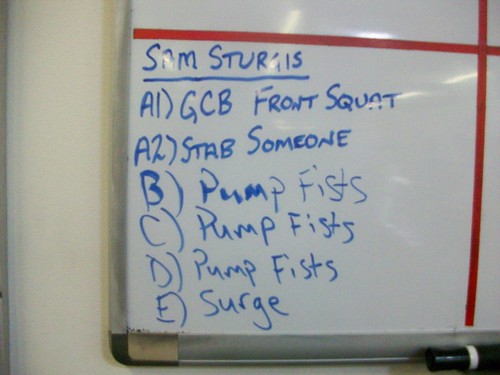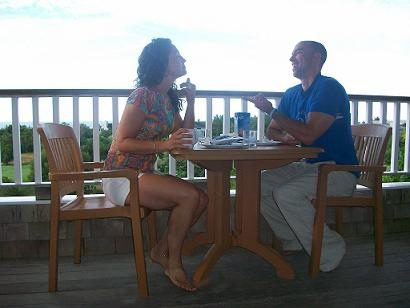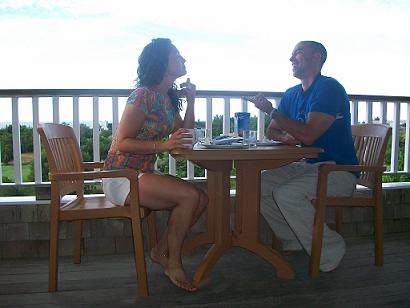Anyone familiar with popular show Extreme Home Makeover knows the premise: a family, fallen on hard times and down on their luck, is sent on vacation for two weeks while Ty Pennington and his team of contractors, designers, carpenters, not to mention an entire town of volunteers, build them a brand spankin new house – hopefully with an indoor bowling alley attached.
If you’re like me, ten minutes into the show, you’re already half way through a box of Kleenex, and when you’re girlfriend happens to show up expectantly – like a ninja – you quickly fumble for the remote and change it to Spike TV or something.
Oh, hey babe. How was your day? Huh, what was that? Why are my eyes all red?
Yeah, well, uh……I just got a little something stuck in my eye, that’s all. I’m gonna go make a sandwich – want one?
Anyways, it’s a great show, and after receiving an email from a distance coaching client of mine (for the sake of anonymity, lets calls him Matt Damon) asking me to critique is deadlift technique, it got me thinking: Why not take the same concept and apply it towards fixing or cleaning up someone’s deadlift?
But first, a little backstory
“Matt Damon” started working with me about a month ago. Like many guys in his situation, he had done several programs on his own, and to no avail, never really saw the progress he was hoping to attain. Frustrated, he decided to contact me inquiring about distance coaching.
Now, before I continue, I’ll be the first to admit: distance coaching definitely has its disadvantages (see exhibit A below), but at the same time – and not to blow sunshine up my own ass – I feel my experience and abilities as a coach trumps any program some local boxed gym, pencil necked personal trainer could come up with.
Not to get into the particulars, but in order to become a client, I have people fill out a few lengthy questionnaires detailing, among others things, stuff like training history, injury history, goals, equipment availability, and other pertinent information like their ideal training split or whether or not they have any weird eating habits (penguin anyone?).
In addition, to help me better ascertain what it is they’re looking to accomplish, I also have them send me some full-body postural pictures (interestingly, some guys will send me a picture of their rear double bicep pose. I have no clue why), and I also ask them to send me a video of their squat and deadlift technique. You know, just to see what’s going on.
Well, fast forward to last week when I received the following email from “Matt Damon:”
Hi Tony–
I just started Week Three, and I realized I never sent you these squat and deadlift videos from my first week. So here they are.
The squats are from my first day when I forgot my gym shoes, so I’m in my street shoes. I also sometimes forgot to pause at the bottom. And the video’s from kind of a funny angle.
I thought my gym had a trap bar, but it turns out they don’t. So I’ve been doing regular deadlifts instead of trap bar deadlifts.
Let me know what you think!
As I noted above, distance coaching has its disadvantages – the most obvious being that I’m unable to be there in person to offer coaching cues and to otherwise keep people from hurting themselves.
That being said, here’s what I wrote back:
STOP……..DOING……THAT…….NOW.
Okay, that’s not really what I wrote, but you can imagine the look on my face when I watched that video for the first time. Truth be told, I don’t think it’s possible for someone’s jaw to drop any further than what mine did.
Nevertheless, “Matt” is a trooper and he’s agreed to allow me to exploit him for your own education. I asked if he’d be cool with me sharing this on my blog, and he was more than willing to participate. So without further ado, here’s the actual email I sent him once I retrieved my laptop after throwing it out the window.
- You need to elevate the bar more. If you load it to 135 lbs (45 lb plates on each side), the bar will be at regulation height. That will help. If that’s too much weight – I’d suggest placing the bar on top of steppers or plates so that you can get it to the right height. From there, a few key points to note
- You’re essentially squatting the bar down. A big no no. Deadlifting should be more of a hip hinge pattern, not squat. So, to that end, try to SIT BACK. Basically you want to focus on pushing your hips back until you feel a pretty significant stretch in the hammies. When you can’t go any further, THEN you’ll bend the knees to get down to the floor.
- The bar should slide down your thigh, but again, you need to SIT BACK!!!! I attached a video to demonstrate what it should actually look like. If you see how I descend, you’ll notice how I don’t have to lower the bar AROUND my knees like you do. See what I’m talking about?
- Moreoever, a great cue I like to use with people is to pretend there’s someone standing behind you with a rope tied around your waist. As you descend, they’re pulling your hips back. See if that helps at all.
- Frankly, there’s a lot more we need to work on, but lets focus on those few things for now and see what kind of progress we can make.
A few days later, “Matt” sent me this (practice) video:
While not perfect by any means (he’s not getting his hips through at the top, his upper back is still just a teeny tiny bit kyphotic, and he NEEDS TO USE MORE WEIGHT. If you can curl it, you certainly shouldn’t be deadliftng it.), it shows a marked improvement from the original video he sent.
if anything, what I hope this demonstrates, is that 1). I’m awesome and 2). More importantly, by just using a few simple cues, you can make huge strides in terms of cleaning up someone’s technique. I think a major mistake that many personal trainers and coaches out there make is trying to OVER coach things and using waaaaaay too many cues that do nothing more than complicate things and frustrate the client.
All I told “Matt” to do was sit back, and feel a stretch in the hammies before bending the knees, and look how many other things just sorta “fell into place” as far as his technique is concerned.
And to think, I did all of this without ever having met him in person. O’Doyle rules!!!!!







